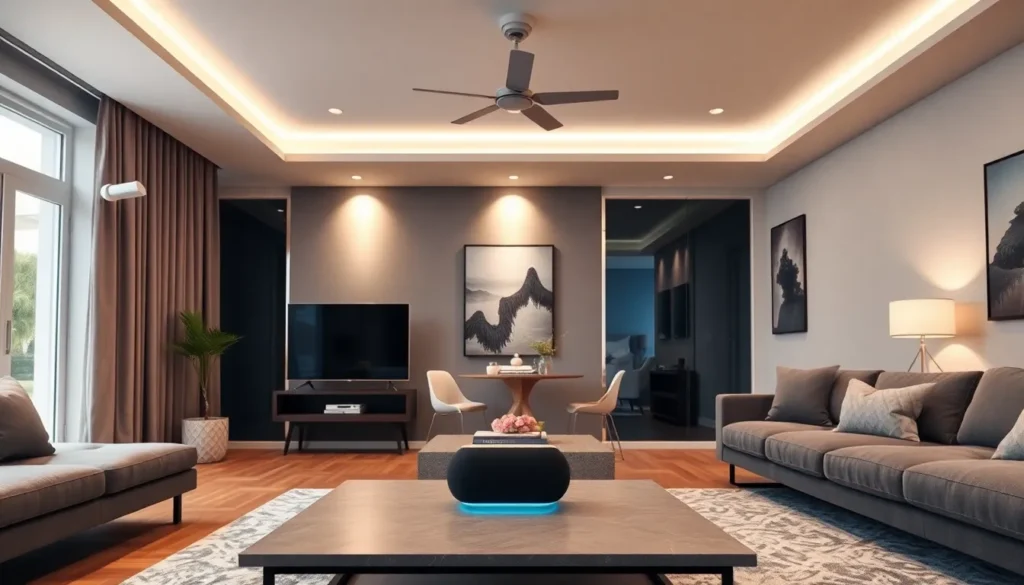Imagine a home where your coffee brews itself, lights adjust to your mood, and your favorite playlist starts playing the moment you walk in. Welcome to the wireless home ecosystem, where convenience meets cutting-edge technology. Gone are the days of tangled cords and remote controls that seem to have a mind of their own. It’s time for a smarter, more connected living space that practically runs on autopilot.
Table of Contents
ToggleOverview of Wireless Home Ecosystem
A wireless home ecosystem comprises interconnected devices that communicate effortlessly, enhancing day-to-day living. This environment fosters automation, control, and convenience in various aspects of daily life.
Definition and Components
A wireless home ecosystem refers to a network of smart devices connected through wireless technology, simplifying management and usage. Key components include smart speakers, security cameras, thermostats, lights, and appliances. These devices often integrate with central hubs or networks, enabling seamless communication. Protocols like Wi-Fi, Bluetooth, and Zigbee facilitate connections, ensuring devices operate in harmony. Homeowners can customize their setups to fit specific needs and preferences, creating a tailored experience.
Benefits of a Wireless Home Ecosystem
Convenience ranks high among the advantages of a wireless home ecosystem. Users can control multiple devices with a single command, reducing the need for physical interaction. Efficiency stands out as well; automated systems optimize energy use, leading to potential cost savings. Enhanced security features provide peace of mind, with real-time monitoring and alerts from smart devices. Flexibility comes into play, allowing homeowners to expand their networks easily, integrating new devices as they become available. Overall, a wireless home ecosystem significantly elevates the living experience through modern technology.
Key Technologies in Wireless Home Ecosystems

Wireless home ecosystems rely on several key technologies to enhance connectivity and functionality. Understanding these technologies provides insight into how they contribute to modern living.
Wi-Fi and Mesh Networks
Wi-Fi serves as the backbone of many wireless home ecosystems. Devices communicate seamlessly using Wi-Fi, allowing for easy access to internet resources. Mesh networks extend Wi-Fi coverage throughout homes, eliminating dead zones. By deploying multiple nodes, homeowners can ensure robust connectivity in larger spaces. Connection speeds often increase as mesh systems streamline data routing. Smart devices, like cameras and speakers, benefit from uninterrupted signals, enhancing their performance.
Zigbee and Z-Wave Protocols
Zigbee and Z-Wave are crucial wireless protocols in smart home communication. These technologies support low-power devices, optimizing energy efficiency. Zigbee operates on a mesh network, facilitating device-to-device communication without extensive central control. Z-Wave emphasizes a lower frequency, reducing interference with Wi-Fi networks. Both protocols enable compatibility among various smart home devices, fostering interoperability. Homeowners can create a more cohesive system, integrating devices from different manufacturers effortlessly.
Popular Devices in Wireless Home Ecosystems
Wireless home ecosystems include a variety of devices that enhance daily living through interconnectivity. Key among these are smart speakers, security cameras, and smart locks.
Smart Speakers and Voice Assistants
Smart speakers serve as central hubs in many wireless ecosystems. They enable users to control other devices with voice commands, creating a hands-free experience. Popular models like the Amazon Echo and Google Nest work with a range of compatible smart devices. Integration with voice assistants streamlines tasks, from playing music to adjusting lights. Features like multi-room audio enhance the listening experience throughout the home. Users benefit from the ability to customize routines for convenience, making smart speakers essential for modern living spaces.
Security Cameras and Smart Locks
Security cameras provide crucial surveillance in wireless ecosystems. They allow homeowners to monitor their property in real-time via mobile devices. Popular brands such as Arlo and Ring offer features like motion detection and night vision for comprehensive security. Smart locks enhance home security by enabling keyless entry through smartphones or codes. Users can grant or revoke access remotely, giving them control over who enters their home. Together, these devices form a robust security system that adds peace of mind and protection to any wireless home ecosystem.
Integration and Automation
Integration and automation in a wireless home ecosystem streamline daily tasks and enhance convenience. Interconnected devices work collectively to create a cohesive living environment.
Setting Up a Seamless Experience
Setting up a seamless experience within a wireless home ecosystem involves careful placement and configuration of devices. Smart speakers, smart lights, and smart thermostats require strategic positioning to maintain strong connections. Mesh networks further extend coverage, ensuring no dead spots disrupt functionality. Utilizing mobile apps simplifies the setup process, allowing homeowners to easily control and manage devices. Regular firmware updates enhance performance, improving security and adding new features. A well-implemented configuration ensures devices communicate efficiently, leading to a smoother user experience.
Creating Custom Routines
Creating custom routines elevates the functionality of a wireless home ecosystem significantly. Home automation platforms allow users to set specific triggers for routines, such as turning off lights when leaving home or adjusting thermostat settings before bedtime. Users can combine multiple actions into one command, such as activating security cameras while locking doors. Voice commands through smart speakers simplify routine execution, making it easy to control multiple devices simultaneously. Personalizing routines according to individual preferences adds another layer of convenience, allowing users to tailor their environment effectively.
Challenges and Considerations
Wireless home ecosystems present various challenges and considerations. Addressing these ensures a smooth and secure connected living experience.
Security Risks and Privacy Concerns
Security risks pose significant challenges within wireless home ecosystems. Devices connected to the internet may face vulnerabilities, making them targets for hackers. Cyberattacks could lead to unauthorized access, posing threats to personal privacy and data security. Furthermore, improper configurations may allow data leaks, exposing sensitive information. Homeowners must prioritize strong passwords and regular software updates. Implementing network security measures, such as firewalls, greatly reduces risks. Lastly, awareness of privacy policies for smart devices helps ensure consumer data remains protected.
Compatibility and Interoperability Issues
Compatibility issues arise when integrating devices from different manufacturers. Not all smart devices communicate seamlessly, which can lead to frustration. Diverse communication protocols can hinder synchronization, requiring additional hubs or solutions. Ensuring compatibility before purchasing devices is essential to avoid conflicts. Homeowners benefit from focusing on ecosystems that support a wide range of products. Seeking out devices marked with interoperability certifications can simplify the integration process. Thorough research into supported platforms can greatly enhance user experience and connectivity within a wireless home ecosystem.
Embracing a wireless home ecosystem transforms everyday living into a seamless experience. With interconnected devices working in harmony, homeowners enjoy unmatched convenience and efficiency. The ability to automate tasks and customize routines enhances comfort and security, making daily life simpler.
However, it’s crucial to remain vigilant about security and compatibility. By prioritizing strong passwords and choosing interoperable devices, users can fully leverage the benefits of their smart home setup. As technology continues to evolve, the potential for innovation within wireless ecosystems will only grow, paving the way for even smarter living solutions.






